How to Design a Craftsman Living Room: Timeless Style & Cozy Decor Ideas
The craftsman-style living room is a celebration of comfort, skilled workmanship, and the enduring beauty of natural materials. Originating in the early 20th century as a response to the mass-produced aesthetics of the Industrial Revolution, this design philosophy remains incredibly popular today. It offers a warm, inviting, and grounded feel, standing in stark contrast to fleeting trends and overly ornate styles. Embracing craftsman elements in your home allows you to create spaces that feel both deeply rooted and profoundly peaceful in an often-overwhelming world.
At its core, the craftsman style champions honest materials, meticulous construction, and a harmonious connection to nature. This focus on quality means that craftsman rooms not only age gracefully but also develop a rich patina and character over time, fostering a sense of stability and belonging. From the rich, warm tones of wood and stone to the practical elegance of its furniture and the soft, inviting glow of its lighting, every element contributes to a cohesive and comforting environment.
This comprehensive guide will explore the essential components that define a craftsman living room, providing you with practical tips and inspiring ideas. Whether you’re planning a complete renovation or simply looking to incorporate a few key pieces, these insights will help you craft a living room that feels both classic and supremely comfortable, imbued with the thoughtful details that make this style so beloved and enduring.
Key Characteristics of a Craftsman-Style Living Room
Craftsman living rooms are instantly recognizable for their distinctive features, which collectively create a welcoming, functional, and aesthetically pleasing space. Understanding these core characteristics is crucial to successfully implementing the style in your own home.
Natural Materials: The Foundation of Craftsman Style
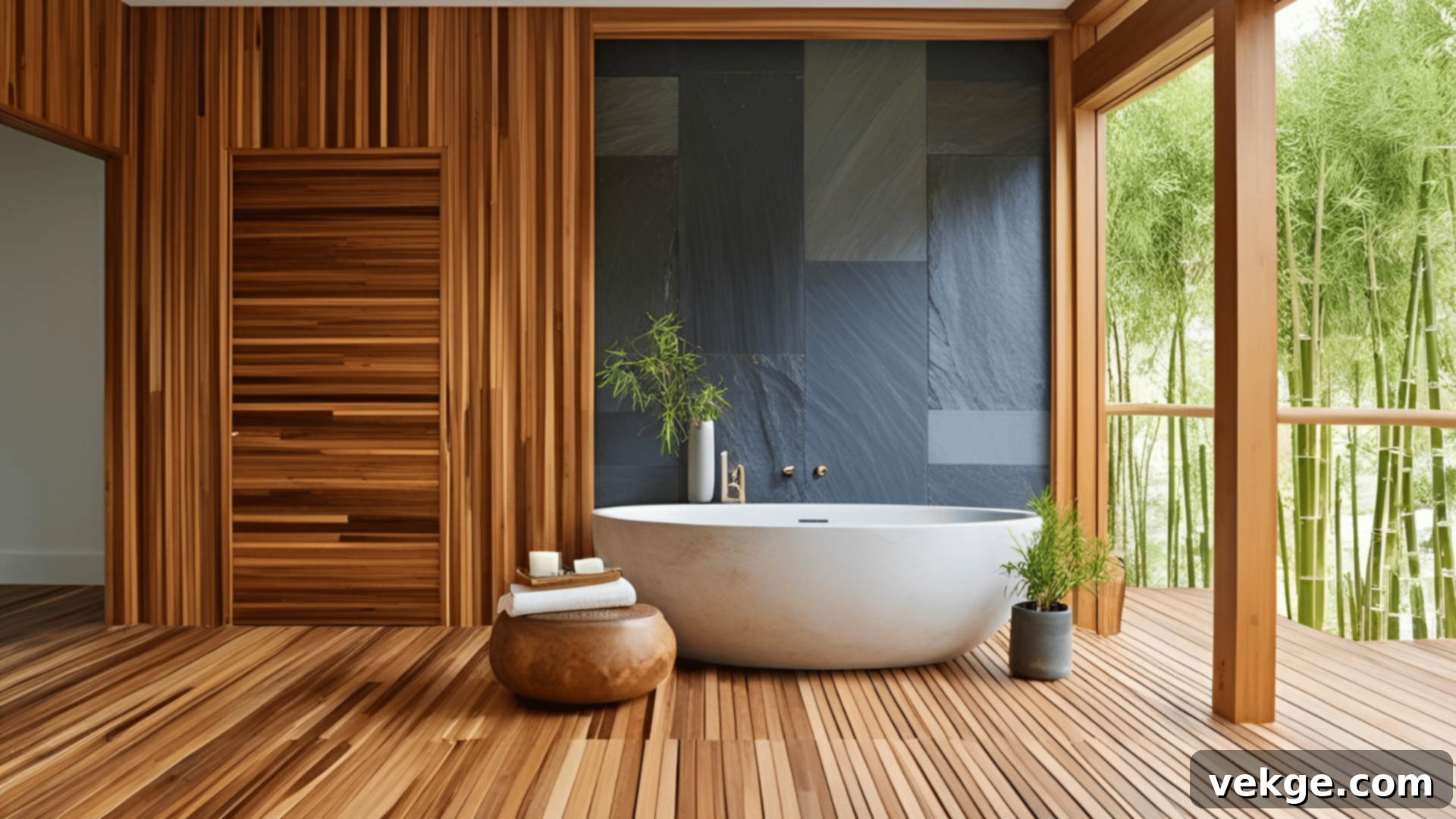
The essence of craftsman design lies in its profound respect for natural materials. Wood, stone, and metal are not merely decorative but are integral to the structure and feel of the space, creating an authentic and grounded atmosphere. Quarter-sawn oak is perhaps the most iconic wood, celebrated for its unique grain patterns and exceptional durability, often used in trim, furniture, and built-ins. Other common woods include cherry, maple, and sometimes dark-stained pine, chosen for their inherent warmth and strength. Stone, such as fieldstone, river rock, or brick, often features prominently in fireplaces, accent walls, or even exterior elements that seamlessly transition indoors. Metals like hammered copper, wrought iron, and bronze are used for light fixtures, hardware, and decorative accents, adding a touch of rustic elegance.
These materials are often left in their natural state or finished simply to highlight their inherent beauty, showcasing the marks of careful craftsmanship. The rough textures of stone, the rich grain of wood, and the subtle sheen of metal work together to create a tactile and visually engaging environment. This emphasis on natural elements not only brings the outdoors in but also cultivates a sense of timelessness and honesty in the living room design, making it feel lived-in and genuinely comfortable.
Open, Inviting Layout: Fostering Connection
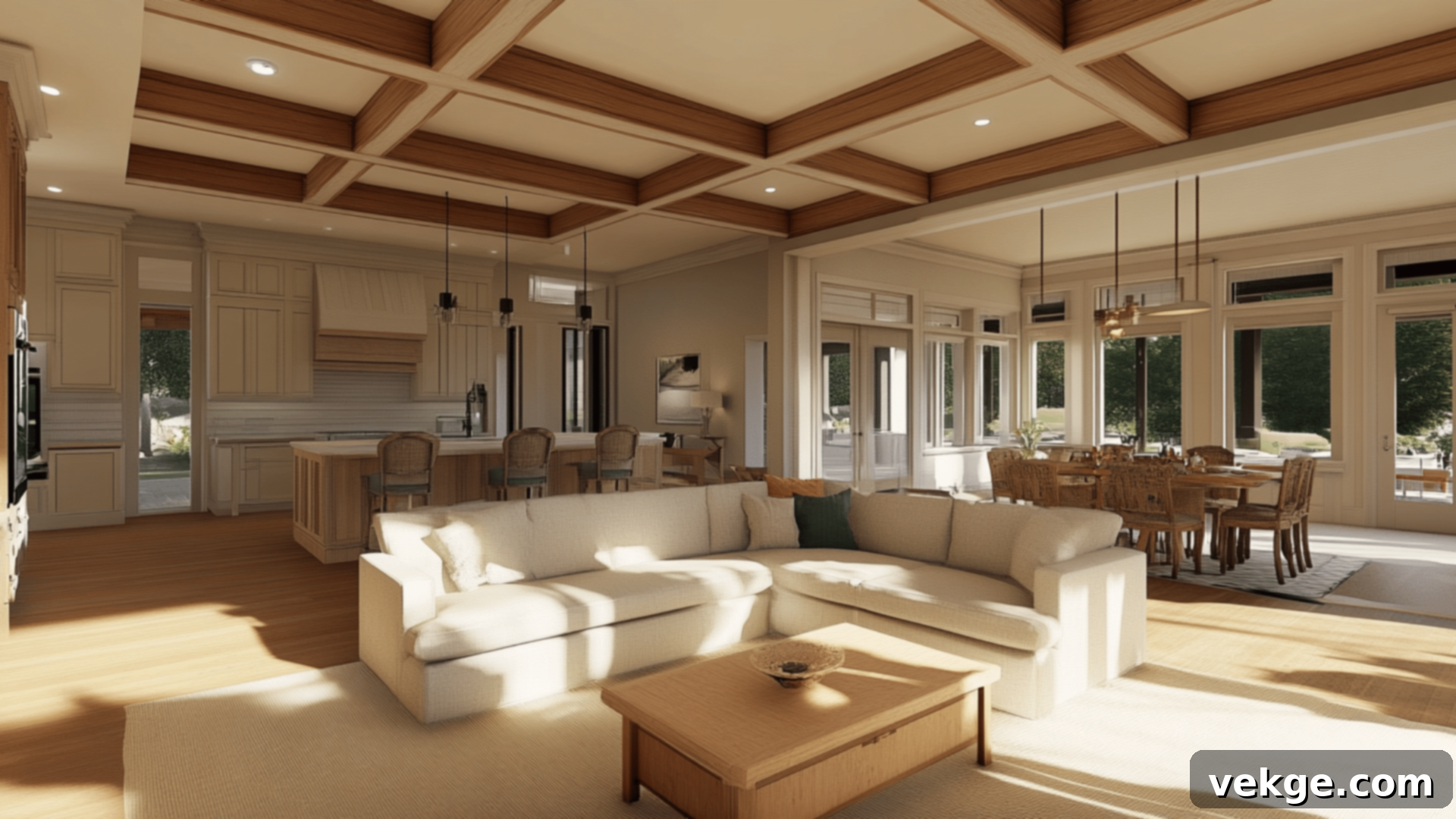
Craftsman living rooms are designed with family life and social interaction in mind. The typical layout promotes an open and inviting atmosphere, often featuring seamless transitions between the living area, dining room, and kitchen. Rather than being enclosed by restrictive walls, these spaces frequently flow into one another, sometimes defined by wide archways or decorative columns. This open-concept design encourages a sense of togetherness and facilitates easy movement, making the home ideal for both everyday activities and entertaining guests.
The goal is to create zones that are distinct yet connected, ensuring that conversations and activities can easily extend across rooms. This thoughtful arrangement enhances the overall functionality of the space, preventing any area from feeling isolated. It reflects the Arts and Crafts movement’s ideal of the home as a central hub for family and community, promoting warmth and connection over formality and separation. In a craftsman living room, everyone feels welcome and at ease, making it a true heart of the home.
Built-In Features: Practicality Meets Artistry
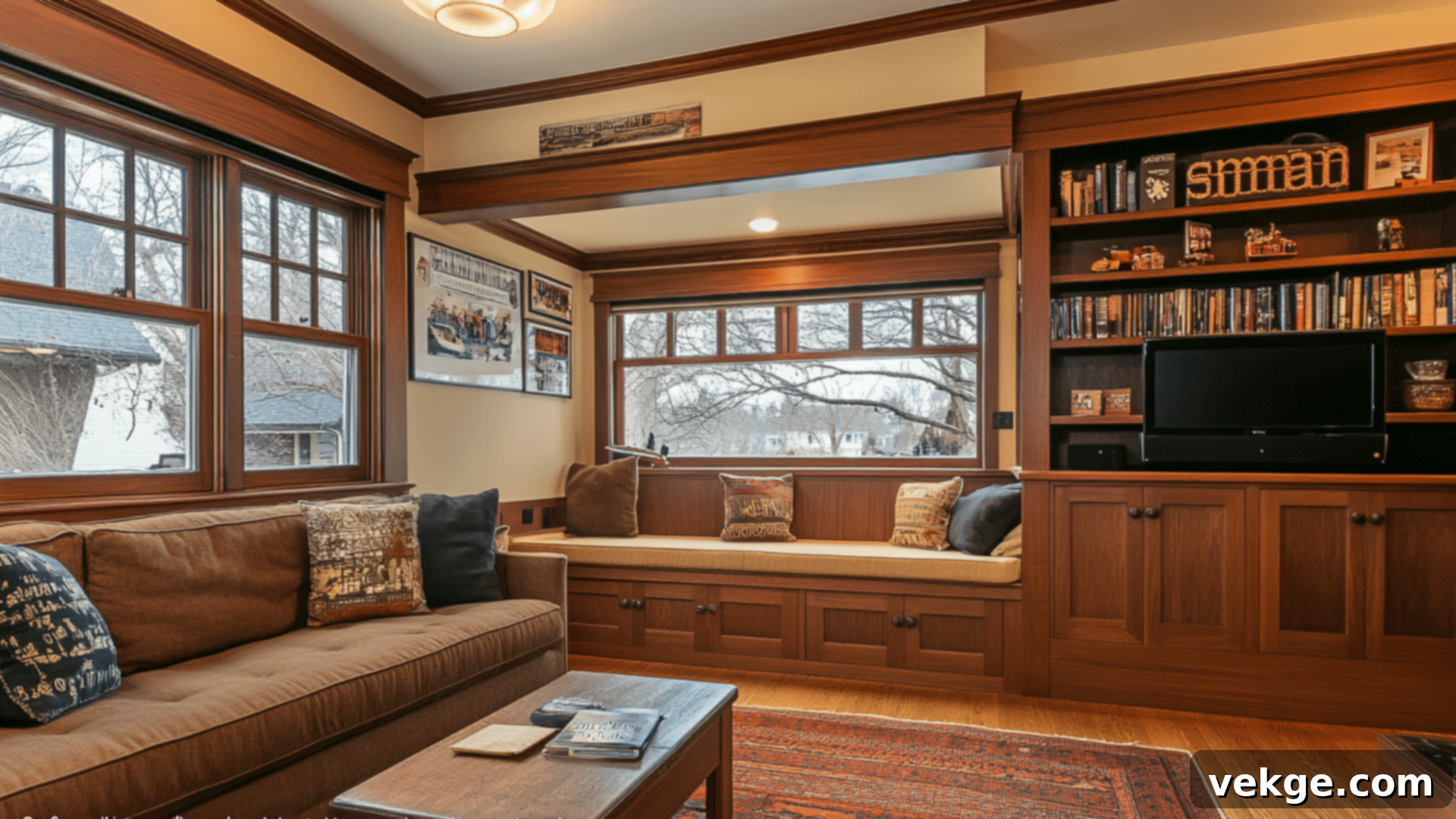
Built-in elements are a hallmark of craftsman style, showcasing skilled woodworking and maximizing space efficiency. Custom shelves, display cabinets, bookcases, and window seats are not just practical additions but are also integral design features. These elements often boast simple, straight lines and robust construction, seamlessly blending into the room’s architecture rather than standing out as separate pieces of furniture. They are designed to appear as if they’ve always been a part of the house, enhancing its character and functionality.
Built-ins serve multiple purposes: they provide valuable storage, offer comfortable seating, and create opportunities to display cherished books, pottery, or art. A window seat, for example, might offer storage underneath while providing a cozy nook for reading. Bookcases flanking a fireplace add symmetry and intellectual appeal. These features are often crafted from the same wood as the trim and other architectural details, ensuring a cohesive and integrated look that reinforces the custom, handcrafted appeal of the craftsman aesthetic. They are prime examples of how utility and beauty are harmoniously combined in this design philosophy.
Craftsman Furnishings: Sturdy, Simple, and Comfortable

Craftsman furniture embodies the style’s core values: durability, simplicity, and comfort. Pieces are typically sturdy and well-made, featuring clean, straightforward lines and minimal ornamentation. This is not a style for delicate or overly ornate furnishings. Instead, look for low-slung, wide chairs and sofas constructed with visible wooden frames, often in quarter-sawn oak. The upholstery fabrics tend to be natural and durable, such as cotton, linen, wool, or leather, in muted, earthy tones that complement the natural wood. Patterns, if present, are subtle, perhaps geometric or inspired by nature.
The emphasis is on functionality and honest construction. Exposed joinery, like mortise and tenon joints, is often celebrated rather than hidden, showcasing the quality of the craftsmanship. Pieces like Mission-style chairs, often associated with the Arts and Crafts movement, are perfect examples of this aesthetic, known for their strong vertical and horizontal lines. Each item should convey a sense of permanence and purpose, inviting occupants to relax and feel supported without the distraction of flashy or overly decorative elements. The goal is to create a living room where every piece of furniture feels substantial, comfortable, and built to last for generations.
Color Palette for a Craftsman Living Room: Grounded in Nature
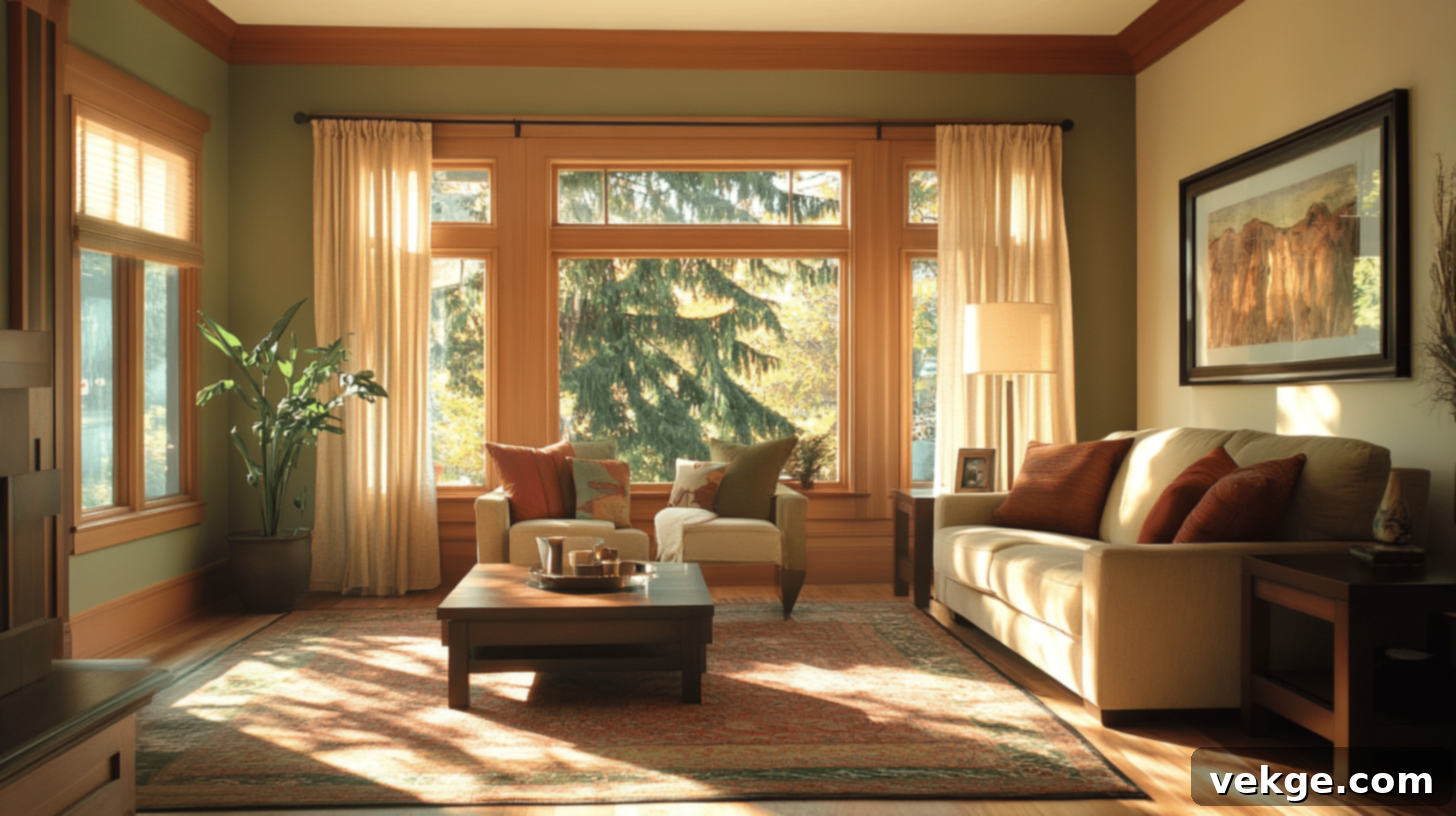
The color palette in a craftsman living room is carefully chosen to echo the natural world, creating an atmosphere that is both welcoming and timeless. These colors enhance the architectural features and material choices, fostering a sense of calm and rootedness.
Earthy Tones: A Foundation of Serenity
The primary color scheme for craftsman spaces revolves around a rich array of earthy tones. Deep browns, warm beiges, and various shades of green form the essential base, reflecting the natural wood and stone elements prominent in the room. Imagine the colors found in a serene forest: the deep browns of tree bark, the varied greens of moss and foliage, the soft grays of river stones, and the warm ochres of autumn leaves. These colors provide a grounding backdrop that allows the natural beauty of wood trim, built-ins, and furniture to truly shine.
Specific shades like sage green, olive green, muted terracotta, warm mustard, and deep caramel are often employed. These colors create a harmonious environment that feels incredibly cozy and stable, encouraging relaxation and contemplation. They are not jarring or overly vibrant but instead offer a soothing visual experience that connects the interior space directly to the tranquility of the natural world.
Accent Colors: Subtle Pops of Personality
While earthy tones dominate, carefully selected accent colors can inject life and personality into a craftsman living room without overpowering its natural aesthetic. Muted reds, deep blues, and softer, more vibrant greens work wonderfully as secondary hues. These colors are best introduced in smaller doses through elements like throw pillows, area rugs, unique pieces of art, or pottery. Think of the deep red of a natural clay pot, the rich blue of a stormy sky, or the vibrant green of fresh spring leaves.
The key is to choose colors that complement, rather than clash with, the natural wood tones and foundational earthy palette. They should add visual interest and a touch of warmth or depth, drawing the eye to specific areas or handcrafted items. Avoid overly bright or neon colors, which would disrupt the serene and natural feel of the craftsman style. The goal is a balanced and inviting space where every color feels intentionally placed and contributes to the overall sense of calm and warmth.
Natural Light: Illuminating the Craftsman Spirit
Beyond paint and fabric, natural light plays a pivotal role in shaping the ambiance of a craftsman living room. Large, often multi-paned windows are characteristic of the style, designed to allow abundant sunlight to flood the interior. This not only brightens the space but also beautifully highlights the intricate grain of wooden surfaces and the varying textures of stone, bringing them to life throughout the day. The connection between the indoor and outdoor environments is a fundamental aspect of craftsman design, emphasizing a seamless transition and an appreciation for nature.
To maximize this effect, window treatments should be simple and unobtrusive. Lightweight curtains in natural fabrics (like linen or cotton) or functional blinds that can be easily drawn up are ideal. The aim is to avoid blocking light or obscuring views of the garden or landscape. The interplay of natural light with the chosen color palette and materials is essential for creating the inviting, warm, and authentic feeling that defines a truly exceptional craftsman living room.
Decor Ideas for a Craftsman Living Room: Honoring Form and Function

Decorating a craftsman living room is about making thoughtful choices that reflect the style’s core values: skilled workmanship, lasting quality, and a comfortable, useful space. Every piece should contribute to a cohesive and inviting atmosphere.
Low, Comfortable Furniture: An Invitation to Relax
Choosing the right furniture is paramount. Opt for deep sofas and solid chairs that are inviting and comfortable, upholstered in natural, durable fabrics such as cotton, wool, linen, or high-quality leather. The ideal craftsman sofa or armchair often sits relatively low to the ground, creating a grounded and approachable feel. Rocking chairs and wide armchairs with visible, sturdy wooden frames and simple, plush cushions are excellent choices, providing perfect spots for relaxation, reading, or quiet conversation. The focus is on creating seating that encourages lingering and a sense of coziness, making the living room a true sanctuary from the outside world.
Wooden Furniture: Celebrating Natural Beauty and Longevity
Wood is the star of craftsman furniture. Look for pieces crafted from solid oak (especially quarter-sawn), cherry, or maple, as these woods showcase beautiful natural grain patterns and develop a rich patina over time. Furniture should feature clean, straight lines and minimal, unpretentious detailing, allowing the inherent beauty of the wood to be the focal point. Avoid highly glossed or overly stained finishes; instead, favor natural or matte finishes that emphasize the wood’s authenticity and texture. The colors of your wooden furniture should harmonize with the room’s trim, built-ins, and overall color scheme, creating a unified and serene environment that feels organically composed and built to endure for generations.
Accent Pieces: The Art of the Handmade
Accent pieces in a craftsman living room should embody the spirit of the handmade. Instead of mass-produced items, seek out artisanal pieces like hand-woven wool rugs, unique pottery or ceramic vases, hand-forged metal lamps, and framed prints or paintings that reflect natural themes. These items add texture, color, and a sense of personal history to the space. Each piece should appear to have been crafted by skilled hands, bearing the subtle imperfections that speak to its authenticity and story. The philosophy here is quality over quantity, with each item serving a purpose or holding special significance, rather than merely existing as pure ornamentation. Curated collections of meaningful objects contribute to a collected and rich narrative within the room.
Focus on Functionality: Beauty in Utility
A core tenet of the craftsman style is that beauty and functionality are inextricably linked. Every piece of decor and furniture should serve a practical purpose while simultaneously enhancing the room’s aesthetic. Consider storage ottomans that double as extra seating and clever hiding spots, coffee tables with integrated drawers for organizing clutter, and robust bookcases that proudly display favorite reads and decorative objects. This commitment to “form follows function” ensures that your living room is not just beautiful to look at but also eminently livable and efficient. It encourages a clutter-free environment where useful items are also beautiful, reinforcing the enduring appeal of craftsman design.
Fireplace: The Focal Point of a Craftsman Interior
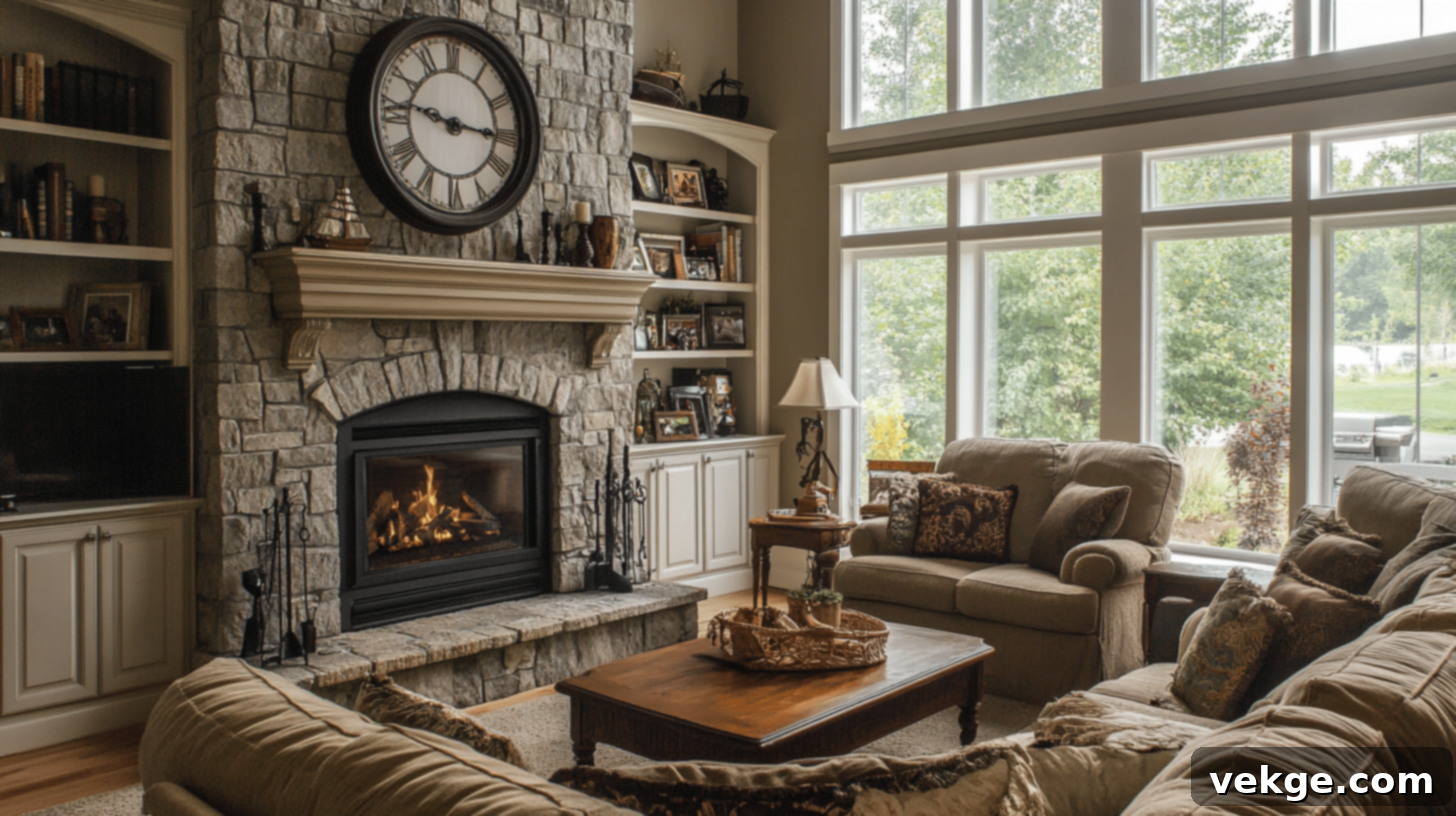
In a true craftsman living room, the fireplace is more than just a heating element; it is the undisputed heart of the home, a powerful focal point that anchors the entire space. It embodies warmth, comfort, and the enduring nature of the craftsman aesthetic.
Classic Hearth: A Symbol of Permanence
A robust stone or brick fireplace is typically the soul of a craftsman living room. It’s designed to look solid, substantial, and utterly permanent, often extending from floor to ceiling. The materials chosen—be it rough-hewn fieldstone, meticulously laid brick, or natural river rock—are intended to showcase their raw beauty and varying textures. These fireplaces are frequently flanked by built-in shelves, display cabinets, or comfortable window seats, creating a grand and inviting architectural feature. The mantelpiece itself is usually a thick, solid piece of wood, often left with a natural finish, providing a simple yet strong shelf for understated decor. The entire structure exudes a sense of strength and tradition, inviting gatherings around its warmth.
Designing Around the Fireplace: Cultivating Conversation
Given its central importance, the living room’s layout should naturally gravitate towards the fireplace. Arrange your main seating—sofas and armchairs—in a comfortable semi-circle or U-shape, facing the hearth. This configuration not only optimizes warmth but also fosters easy conversation and a strong sense of intimacy among those gathered. Ensure that the arrangement allows for clear pathways and easy movement around the room, preventing a cramped feeling. The fireplace acts as a natural magnet, drawing people together and creating a designated zone for relaxation and connection. Complementary pieces like a sturdy coffee table or ottoman should be placed centrally, within easy reach of all seating, further enhancing the functionality of this central gathering space.
Mantel Decor: Simplicity and Significance
Decorating the fireplace mantel in a craftsman living room requires a “less is more” approach. The strong architectural presence of the fireplace itself is often enough, and decor should enhance, not detract from, its solidity. Opt for a few carefully chosen, significant items rather than an abundance of small trinkets. A plain, well-crafted wooden clock, a pair of simple framed family photographs, a collection of handmade ceramic vases, or a set of matching hammered metal candlesticks are ideal. These pieces should echo the natural materials and clean lines of the room. Avoid cluttering the mantel with too many items or overly ornate decorations, as this can create a busy and chaotic look that clashes with the serene and grounded craftsman aesthetic. Each item chosen should have a story or a visual weight that holds its own against the substantial backdrop of the fireplace.
Lighting in a Craftsman Living Room: Warmth and Illumination
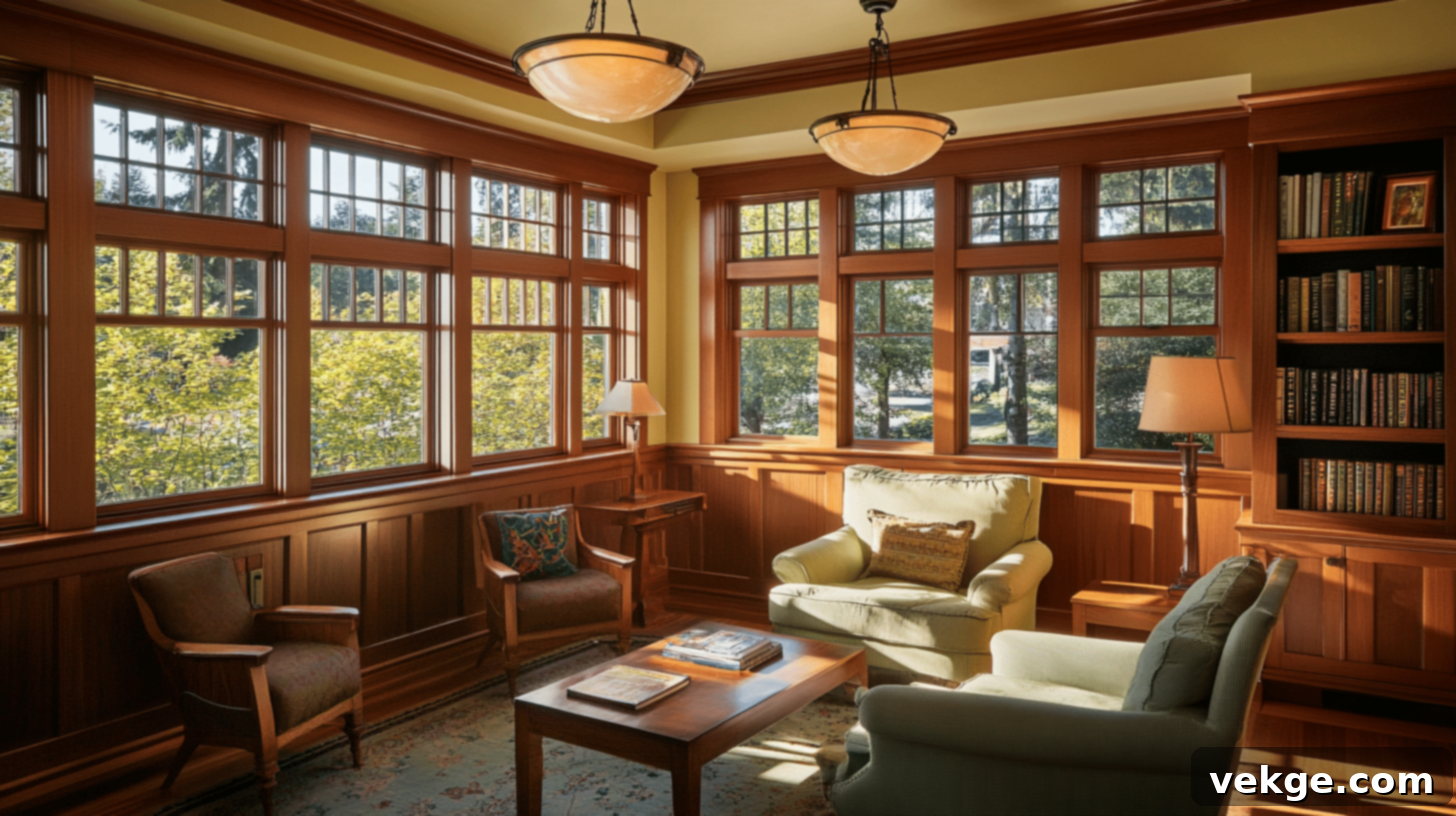
Thoughtful lighting is essential for enhancing the warm, inviting atmosphere of a craftsman living room and showcasing its beautiful features. It contributes significantly to the overall comfort and functionality of the space.
Natural Light: Maximizing Outdoor Connection
As mentioned, natural light is a cornerstone of craftsman design. Large windows, often arranged in groups of two or three, are strategically placed to maximize sunlight entry and offer expansive views of the outdoors. These windows typically feature robust wood trim and simple glass panes, sometimes with small, decorative leaded or stained-glass accents at the top, reminiscent of traditional artistry. They serve not only to illuminate the room but also to forge a strong visual connection between the interior and the surrounding landscape. The ever-changing patterns of natural light throughout the day bring dynamism and life to the rich textures and colors within the room, reinforcing the style’s connection to nature.
Craftsman Light Fixtures: Artistry in Illumination
Artificial lighting in a craftsman living room should be both functional and aesthetically aligned with the style’s handmade ethos. Look for light fixtures that combine sturdy metal bases—such as bronze, copper, or wrought iron—with distinctive shades. Popular choices include shades made from mica, which emits a warm, diffused glow, or art glass, featuring geometric patterns or muted stained glass in earthy colors. Tiffany-style lamps, with their intricate leaded glass designs, are particularly fitting. These fixtures often employ clean lines, geometric shapes, and a substantial presence that complements the overall robust nature of craftsman decor. Whether they are ceiling pendants, wall sconces, or table lamps, craftsman light fixtures serve as beautiful, functional art pieces that enhance the room’s character.
Layered Lighting: Creating Ambiance and Functionality
To achieve optimal illumination and mood versatility, a craftsman living room benefits greatly from a layered lighting scheme. This involves combining different types of light sources to create various levels of brightness and ambiance. Start with ambient lighting from ceiling fixtures or decorative pendants to provide general illumination. Supplement this with task lighting, such as reading lamps placed beside seating areas, to provide focused light for activities. Finally, add accent lighting—perhaps wall sconces highlighting artwork or built-in bookcases, or dimmer-controlled lamps—to create soft pools of light that enhance specific features and add warmth. This layered approach allows you to adjust the lighting to suit any occasion, from bright and functional for daily tasks to soft and inviting for relaxed evenings, ensuring the living room is always comfortable and well-lit.
Integrating Modern Elements with Craftsman Style
While rooted in tradition, craftsman style is remarkably adaptable, allowing for the seamless integration of modern elements without sacrificing its timeless appeal. The key is to blend contemporary conveniences and aesthetics thoughtfully, ensuring they complement rather than clash with the inherent warmth and handcrafted quality of the style. This approach ensures your craftsman living room remains functional and relevant for today’s lifestyle while preserving its cherished character.
Here are some effective ways to thoughtfully mix old and new:
- Streamlined Lighting Choices: While classic craftsman fixtures are iconic, modern takes on simple shapes can work well. Choose basic lighting fixtures that maintain clean lines but might feature contemporary materials like brushed nickel, matte black, or geometric forms, adding a subtle touch of modernity without being overtly futuristic.
- Strategic Color Accents: Introduce small, deliberate pops of slightly brighter or more contemporary colors. This could be through a single throw pillow in a muted teal or a piece of abstract art with a touch of mustard yellow, offsetting the traditional earthy tones. These subtle infusions can update the palette without disrupting the overall grounded feel.
- Biophilic Design: Enhance the natural connection by incorporating an abundance of indoor plants. Large, leafy plants in simple ceramic pots or hanging planters can bring a fresh, vibrant, and very current “green” element into the space, softening hard lines and improving air quality, all while staying true to the nature-loving craftsman ethos.
- Hidden Technology: Integrate modern technology discreetly. Install hidden charging stations within side tables or built-in cabinets, incorporate smart home devices that are camouflaged, or opt for a flat-screen TV that can be recessed or concealed when not in use. This keeps the aesthetic clean while providing all the benefits of modern convenience.
- Updated Window Treatments: While heavy drapes might feel too traditional, replace some window coverings with simpler, more minimalist options like woven wood blinds, roller shades in natural textures, or even sheer linen curtains that allow maximum natural light while maintaining privacy and a soft, inviting feel.
These thoughtful integrations ensure your craftsman living room perfectly balances historical charm with contemporary living, proving that classic style can indeed evolve and thrive in the modern era, creating a space that is both beautiful and highly functional for today’s needs.
Common Mistakes to Avoid in a Craftsman Living Room
Designing a craftsman living room involves balancing several key elements. Being aware of common pitfalls can help you avoid missteps and create a truly authentic and harmonious space that embodies the style’s enduring appeal.
- Overdoing the Decor: A fundamental principle of craftsman design is simplicity and the celebration of handcrafted quality. A common mistake is cluttering the space with too many decorative items or an excess of small, insignificant pieces. This detracts from the substantial, well-made furniture and architectural features. Instead, practice restraint; choose fewer, higher-quality, and meaningful items that can truly be appreciated, allowing them space to breathe and tell their story.
- Choosing the Wrong Furniture: Selecting furniture that clashes with the craftsman aesthetic can quickly undermine the entire design. Avoid overly ornate, delicate, highly modern, or flimsy pieces. Ornate Victorian furniture, sleek minimalist designs, or mass-produced, low-quality items will look out of place. Stick to sturdy, solid wood furniture with clean lines, natural upholstery, and a handcrafted feel that speaks to durability and purpose.
- Ignoring the Balance of Natural Materials and Neutral Tones: The craftsman style is deeply rooted in nature. Neglecting the use of authentic wood, stone, and natural fabrics, or deviating too far from an earthy, muted color palette, will strip the room of its warmth and authenticity. Ensure that your chosen materials and colors work together harmoniously, creating a cohesive, grounded, and calming environment that truly feels connected to the natural world.
- Using Too Many Busy Patterns: While subtle patterns can add interest, an overuse of bold, elaborate, or clashing patterns can overwhelm a craftsman living room, which thrives on understated elegance. Limit busy designs to one or two key areas, such as a statement area rug, a few throw pillows, or a piece of stained-glass art. Opt for geometric patterns, organic motifs, or plain textures that complement rather than dominate the space.
- Picking Poor-Quality or Imitation Materials: The integrity of craftsman design relies heavily on genuine, high-quality materials. Using laminate flooring instead of real wood, synthetic stone veneers over actual stone, or cheap, synthetic fabrics instead of natural fibers will diminish the room’s character and longevity. Invest in real wood, actual stone, and natural fabrics, as these materials not only look better but also age gracefully, developing character and contributing to the timeless appeal of the craftsman style.
Wrapping Up: Cultivating Your Craftsman Sanctuary
Creating a craftsman-style living room is a rewarding endeavor that goes beyond mere aesthetics; it’s about making deliberate choices that honor quality, comfort, and simple, enduring beauty. By thoughtfully selecting natural materials, embracing a warm and earthy color palette, and furnishing your space with well-made, functional pieces, you can cultivate a living room that serves as both a tranquil retreat and a welcoming hub for family and friends.
Don’t feel overwhelmed by the prospect of transforming your entire space at once. Begin small, perhaps by introducing a few key craftsman elements, such as a solid wood coffee table, a handcrafted metal lamp, or a collection of artisan pottery. Over time, as you discover pieces that resonate with your personal taste and the spirit of the style, gradually add more craftsman elements. This organic approach ensures that your living room evolves authentically and reflects your appreciation for enduring quality.
The true magic of the craftsman style lies in its ability to improve with age and use. Like the handcrafted pieces that fill these spaces, a craftsman living room gains character and a richer story over the years. It becomes a testament to thoughtful design and skilled artistry, resisting the fleeting nature of trends.
Ultimately, your craftsman-style living room can become the comforting and inspiring heart of your home – a cherished place where beauty and usefulness coexist in perfect harmony, inviting you and your loved ones to relax, connect, and simply be.
